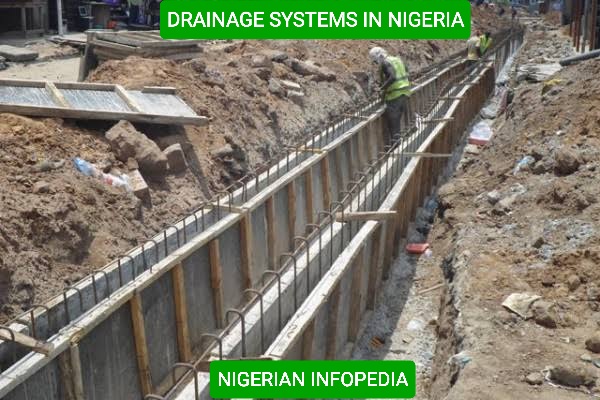Types of Drainage Systems in Nigeria: Full List
Drainage system is a very important factor for housing and agricultural projects. It is the removal of surface and subsurface water from a wet area through natural or artificial drainage. Most agricultural soils have adequate internal drainage to prevent severe waterlogging, which can lead to anaerobic conditions that hinder root growth. However, many soils require artificial drainage to increase production or control water supplies.

It’s appropriate to confine and distribute runoff water because farmers need it to hydrate their vegetation. The freshwater supply of a town is also replenished using the gathered water. Water becomes more contaminated the longer it remains on a surface. You will have a better understanding of their functions and how they interact if you are aware of the different drainage system types. The various drainage techniques used in Nigeria will be thoroughly discussed in this article.
MAJOR TYPES OF DRAINAGE SYSTEMS IN NIGERIA
Here are the various major drainage system types in Nigeria.
DOWNSPOUT AND GUTTER SYSTEMS
The most common drainage system in housing units is the downspout and gutter system. The downspout is linked to the gutter, which is how this drainage system functions. The extra water that accumulates on the building’s roof is then removed by the gutter. If the gutter and downspout are not built, the surplus water would fall directly on the ground and the home, possibly causing erosion and damage. Additionally, improperly built gutters and downspouts can result in flooding and water pooling. The downspout serves as the gutter’s drain. Along with carrying rainfall from the gutter to the ground, it also functions as a pipe.
The water that has accumulated on the roof is subsequently directed toward the ground. In order to avoid water from gathering at the downspout’s base, the downspouts discharge the water haphazardly. The water is emptied into a rain bucket or an extension made of aluminum. Water is sent via this aluminum to other drainage systems near the house. Additionally, they might be directed into subterranean drainage systems. All of them are done to prevent flooding in the compound.
The downspout makes sure that rainfall does not splash against the building during a downpour but instead drains into the earth via the gutter. Another thing to keep in mind about the downspout is that the water is released far away from the building’s foundation at the base to avoid any possible harm.
SUBSURFACE DRAINAGE SYSTEM
Subsurface drainage system is the type of drainage system that is typically buried beneath the ground. The primary goal of the subsurface drainage system is to remove any extra water that has built up in the ground. A subsurface drainage system prevents the vegetation in the garden from rotting because any stored water can harm them when you have a garden or small farm in your compound.
The pipes that make up the subsurface drainage system are directed underground to act as a drain. To get rid of any extra water at the root level, the drain is positioned beneath the soil’s top layer. Trenches must be dug and underground pipes must be constructed for the subsurface drainage system. This kind of drainage system is frequently referred to as a French drain. Another option for the subsurface drainage system is a network of wells.
By deeply plowing the soil, it is possible to create the subsurface drainage system. Due to increased soil aeration brought about by plowing, subsurface drainage improves the general state of the soil. Additionally, this kind of drainage system lowers soil salinity. The subsurface drainage system directs wastewater from the structure to avoid flooding. It is well known that standing water can serve as a mosquito breeding site.
The subsurface drainage system aids in the removal of extra water, which reduces the possibility of water contamination. The risk of erosion is also reduced by the subsurface drainage system. This erosion may be brought on by water ponding, which makes the soil muddy and encourages erosion. The subsurface drainage system controls the moisture level of the soil as well. The high cost of installing and maintaining this kind of drainage system is one of its drawbacks.
SLOPE DRAINAGE SYSTEM
Slope drainage system consists of underground pipes built under. It causes water to slant downward as it leaves the structure. As a result, slope drains enable water to pass via a pipe that slopes downhill. Typically, either concrete, steel, or plastic is used to build these pipes. There won’t be any accidents because the pipes are always covered.
Systems for drainage on slopes reduce installation costs. Additionally, it reduces installation time, saving the land owner some money that would have been incurred during construction. Due to its high efficiency, a slope drainage system significantly decreases the need for maintenance.
The slope drainage system consequently has a self-cleaning effect. Stones, mud, and other materials that have accumulated owing to the lack of rain are carried together with the water as it flows down the drainage network. This is made possible by the slope drainage system. As a result, a slope drainage system requires less maintenance and cleaning. The low construction cost of slope drainage systems is another advantage. The slope drainage regulates the flow of the rainfall on rainy days.
SURFACE DRAINAGE SYSTEM
A surface drainage system is one that is appropriate for flat ground. Rainwater may collect on flat surfaces when the soil is level. If there is no suitable drainage system, this could cause water to collect and pose a threat to the building.
Systems for surface drainage might be used as a driveway or maybe even a walkway. Simply digging a few ditches, which act as a funnel for the extra water, is all that is required to create a surface drainage system. These ditches channel water away from the ground, reducing flooding.
A surface drainage system is built with ditches that act as canals for the water to pass through. This stops floods. The various varieties of surface drainage systems include humps, hollows, and open drains.
CONCLUSION
Agriculture along with building construction and upkeep both depend on proper drainage. It is crucial because contamination could develop if the water remains on the earth’s surface for an extended period of time. For this reason, a reliable drainage system is required. They safeguard the foundation of your building in addition to preventing contamination. Wastewater is appropriately disposed of thanks to the way drainage systems are made. Drainage systems also preserve the structures’ hygienic characteristics. There are numerous types of drainage systems, including downspout and gutter systems, slope drainage systems, subsurface drainage systems, and surface drainage systems.

